Importance of Regular Wallpaper Maintenance
Regular maintenance of textured colored wallpaper is crucial for preserving its aesthetic appeal and functional integrity. Unlike regular flat wallpapers, textured designs require specific attention due to their intricate surfaces. A well-maintained wallpaper can significantly enhance the ambiance of a room, making it crucial for homeowners and interior decor enthusiasts.
Deep Cleaning Frequency
Experts suggest a deep cleaning schedule that aligns with the type of wallpaper and the environment it is in. For instance, wallpapers in high-traffic areas may necessitate quarterly deep cleaning, while those in less-used spaces might only require biannual attention. This routine helps in maintaining the vibrancy and texture of the wallpaper.
Dry Cleaning Techniques for Textured Wallpaper
Dry cleaning is a preferred method for many textured wallpapers, especially those that may not withstand moisture. It’s effective for removing dust and light dirt without risking damage to the wallpaper's surface.
Vacuuming with Care
- Use a HEPA vacuum cleaner.
- Start from the top, working downwards in long, even strokes.
- Avoid pressing too hard to prevent damage.
- Pay attention to corners and edges for spider webs and dust accumulation.
For optimal results, vacuum in sections, ensuring each area is thoroughly cleaned before moving on.
Wet Cleaning Methods: When and How
Not all textured wallpapers can be cleaned with water, but for those that can, wet cleaning can be a more thorough option. It requires careful application to prevent damage.
Testing Before Cleaning
Always test a small, inconspicuous area before proceeding with a full clean. If the wallpaper doesn’t bleed or discolor, proceed cautiously with a slightly damp sponge.
Proper Sponge Technique
- Use a large sponge with a gentle detergent.
- Ensure the sponge is well wrung out to avoid excess moisture.
- Clean with long, even strokes and apply gentle pressure.
- Re-test small areas intermittently to ensure no damage is occurring.
Choosing the Right Cleaning Materials
The materials used for cleaning can make a significant difference in maintaining the wallpaper's appearance. When selecting cleaning tools and agents, consider their compatibility with your wallpaper type.
Recommended Cleaning Tools
- Microfiber cloths for dusting.
- Dry chemical sponges for soot and heavy dirt.
- Gentle, dye-free soaps for washable wallpapers.
Addressing Stains and Marks Safely
Stains and marks can significantly detract from the visual appeal of your wallpaper. Addressing them promptly and correctly is key to maintaining the wallpaper's pristine condition.
Spot Cleaning Tips
- For grease, use a paste of cornstarch and water.
- Scuff marks can be removed using a mixture of vinegar and water.
- For crayon marks, a fine steel wool pad can be effective.
Understanding Different Wallpaper Types
Textured wallpapers come in various materials, each with unique cleaning needs. Knowing the type of wallpaper is essential for choosing the correct cleaning method.
Vinyl Wallpapers
Vinyl wallpapers are generally more robust and can handle moisture better than fabric-based or other textured wallpapers. This durability makes vinyl a popular choice among manufacturers and consumers.
Custom Wallpapers from China
China, renowned for its vast manufacturing capabilities, offers a wide range of custom wallpaper options. These can vary significantly in material quality and cleaning requirements.
Special Care for Delicate Wallpaper Types
Certain wallpapers, such as silk or grasscloth, demand extra care due to their delicate nature. These types are more prone to damage from conventional cleaning methods.
Handling Delicate Wallpapers
Use a soft brush attachment on a vacuum to remove dust gently. Avoid any water-based cleaner unless explicitly recommended by the manufacturer.
Avoiding Common Cleaning Mistakes
To preserve the integrity of textured wallpaper, it's crucial to avoid common cleaning errors. Hard scrubbing or using the wrong products can cause irreversible damage.
Key Mistakes to Avoid
- Do not apply spray-on cleaners directly to the wallpaper.
- Avoid using abrasive scrubbers or overly rough cloths.
- Do not use excess water, which can cause the wallpaper to lift or discolor.
Supplementary Cleaning: Baseboards and Trim
After cleaning the wallpaper, it’s essential to address surrounding areas like baseboards and trim. These areas can harbor dust and dirt, affecting the overall cleanliness of the room.
Cleaning Baseboards
Use the same cleaning solution for wallpaper to clean baseboards. Follow up with a dry cloth to prevent moisture damage.
Odor Removal After Cleaning
Textured wallpapers can sometimes retain odors, especially in rooms like kitchens or bathrooms. Odor removal is an important final step in the cleaning process.
Hydroxyl Generators
Setting up a hydroxyl generator can help remove lingering odors. Typically, this process takes between 24 to 48 hours, depending on the odor's intensity.
Meraki Provide Solutions
Meraki offers specialized cleaning solutions tailored to the unique needs of textured colored wallpapers. With a focus on custom solutions and leveraging advanced techniques, Meraki ensures thorough and safe cleaning. Our approach considers the specific demands of wallpapers produced by manufacturers worldwide, including those from China. By choosing Meraki, you are opting for a professionally crafted solution ensuring the longevity and beauty of your wallpaper while minimizing any risk of damage.
User hot search: textured coloured wallpaper
Post time: 2025-09-12 20:45:03


